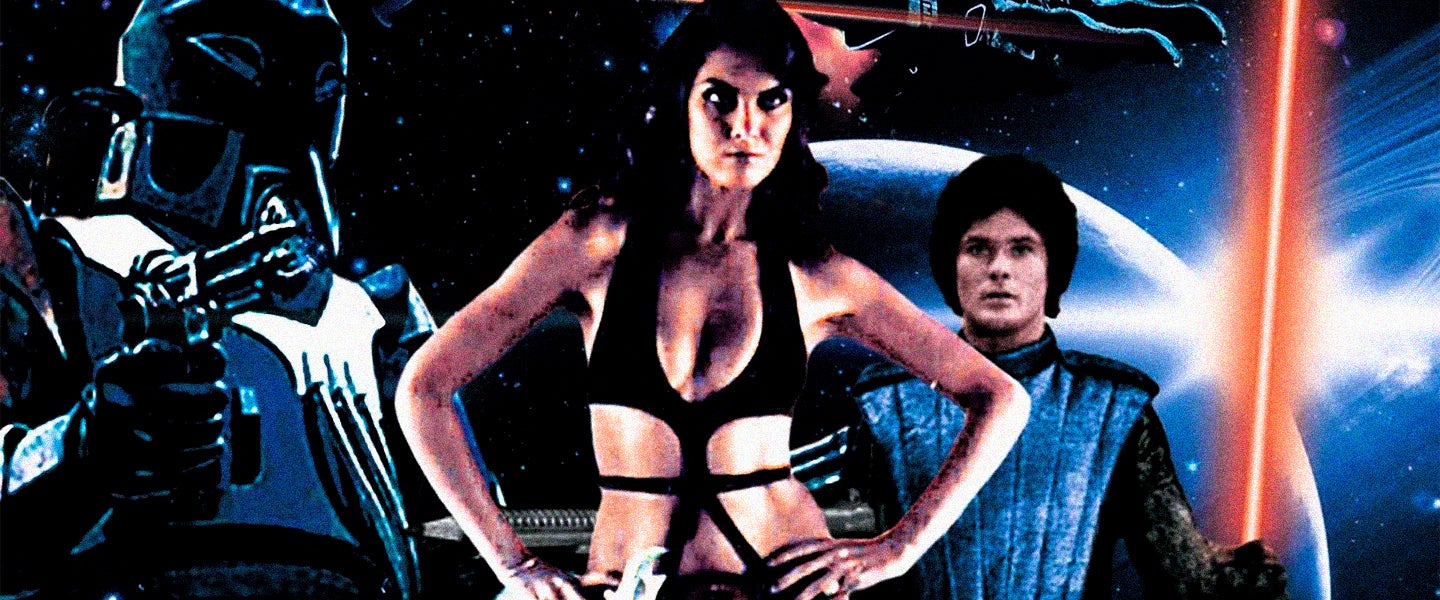In 1979, audiences finally had a chance to miss Star Wars. Released on May 25, 1977, George Lucas’ film had become a phenomenon like no film before it, playing in some theaters for over a year. Its official release ended on July 20, 1978, but its first re-release followed soon — extremely soon: The film now known as Star Wars: Episode IV — A New Hope officially returned to theaters on July 21, 1978 and stayed there until November. But once it was gone, it was gone, and in those pre-video store days, that meant fans didn’t have a chance to see it at all. That left a void to be filled and a suddenly science fiction-crazed public looking for something, anything to fill it.
Enter Starcrash, a film with a funny robot, laser swords and spaceships doing battle above far-off planets that looked like Star Wars — at least, for those who squinted. But Starcrash was no mere knockoff, even if any resemblance was far from coincidental: Beneath its surface lay a strange fever dream of a movie, the product of intense, fast-paced labor and an obvious love for science fiction, scantily clad women and strange stories about the clashes of good and evil that follow the dream logic of half-remembered B-movies.
Stephen Romano — a writer and artist who lists Starcrash as his all-time favorite movie and provides an audio commentary for its Shout! Factory-released Blu-ray edition — gets at the source of some of the madness when he describes it as, “an Italian film, produced by French people, starring British people, inspired by every American trend going on in film around that time.” But I say only some, because what can really explain a film that begins with some under-the-spaceship shots obviously inspired by Star Wars’ opening moments, but within minutes gives viewers a weapon that takes the form of a psychedelic light show; a Southern-accented “police robot”; and a character exclaiming “Go for hyperspace!” and “What in the universe is that”? Or one whose cast includes a beloved future Academy Award-winner, a former child preacher who’d starred in a lid-blowing documentary, a recent Bond Girl and David Hasselhoff?
A quick summary, insofar as that is possible: Starcrash stars Caroline Munro — a British veteran of Hammer horror movies, as well as stop-motion animation legend Ray Harryhausen’s The Golden Voyage of Sinbad and Roger Moore Bond flick The Spy Who Loved Me — as Stella Starr, a smuggler who, shortly after the film opens, rescues the lone survivor of a film-opening space battle. She’s soon arrested by the space police already on her trail and sentenced to hard labor by a disembodied head. Said labor apparently involves carrying oversized beach balls across a platform while wearing a leather bikini and thigh-high boots. (“I’ve been at this for 12 straight hours! The radiation will burn my skin off!” she complains, while sporting hair that looks like she just stepped out of a make-up chair.)
After leading a rebellion, she’s rescued by the very space police who sent her there and reunited with her co-pilot Akton, played by ex-kid evangelist Marjoe Gortner. (Gortner never breaks a smirk and uses a drive-time DJ voice to deliver odd lines like, “Even as you speak it’s been taken care of.” The character was conceived as an alien, but Gortner refused to act in either make-up, or a white fright wig he described as making him look like “a 90-year-old Shirley Temple.” In some ways, Akton seems weirder for looking so normal.) They’re greeted by the Emperor of the Galaxy (Christopher Plummer) who charges them with recovering a secret weapon and his son, with some help from the green-skinned Thor (Robert Tessier) and Elle (Judd Hamilton), the twangy-accented robot who first busted them.
Then… well, the film features space amazons, a metallic stop-motion colossus, blade-wielding robot guards and laser swords — including one wielded by Hasselhoff — that look more than a little like lightsabers. Good triumphs over evil, and Plummer returns just in time to talk directly to the camera and tell the audience, “Well. It’s done. It’s happened. The stars are clear. The planets chime. We’ve won. Oh, some dark force, no doubt, will show its face once more. The wheel will always turn. And for a little time, at least, we can rest.” Then the credits roll over James Bond composer John Barry’s majestic score and a puzzled audience is left to wonder what they’d just seen.
Starcrash’s origins are obvious in some respects, but its roots go deeper than you might expect. Italian filmmaker Luigi Cozzi had kicked around the film industry for years, starting out as a protege of Suspiria director Dario Argento. (The two would remain close, and years later, Cozzi would help run Argento’s movie memorabilia store in Rome.) A longtime science-fiction fan who’d published short stories in reputable anthologies, he’d lobbied for years to make a science-fiction passion project of his own. Among those he’d pitched: the Belgium-born, Hollywood-based producer Nat Wachsberger. Inspired by the success of Star Wars upon its American release in May 1977, Wachsberger warmed to Cozzi’s idea — sort of. As per the Blu-ray, he reached out to the director, telling him, “I don’t want to do your project. I want to do Star Wars.’” What’s more, Wachsberger wanted a complete story in 10 days.
Cozzi, who chose the credit “Lewis Coates” for the film, had never had a chance to see Star Wars, but he did have a novelization of the film, which had been published the previous November (though Cozzi recalls buying it even earlier). Using the novel as a model, he tapped out a story that included the other elements Wachsberger requested: a girl, a robot and an alien (not suspecting that his alien actor would refuse to look like, well, an alien). In the rush to bring the film to the screen, he turned to an effects team that included Armando Valcaudo, a cartoonist and stop-motion animator who’d largely worked in commercials up until that point, but leapt at the chance to pay homage to his idol, Harryhausen.
Production began in October 1977, a month before Star Wars reached Italy. Years later, in an interview included on the Blu-ray, Valcaudo recalled the production as proceeding with “schedule-work … in [the] Italian way. They changed, many times, some parts of the screenplay […] and all the expectations were confused, and also the budget.” Nevertheless, Cozzi emerged with a complete, if not-entirely-coherent film at the end of it — one that could at least be marketed to look like Star Wars.
Which it was, extensively. Its German poster, for instance, essentially put Gortner in a Luke Skywalker costume and misleadingly presented the goofy Elle as a looming, Darth Vader-like menace. In North America, where Roger Corman’s New World Pictures distributed the film, the trailer and TV spots emphasized its most Star Wars-like elements.
The approach worked, within reason: In the U.S., Starcrash debuted to $475,000, a first-week record for the then-fledgling New World. Its kindest reviews treated it with amusement. More typical was Eleanor Ringel’s reaction in The Atlanta Constitution, who called it a “shoddy little film” and noted that Munro’s major talent was “possessing the kind of curvaceous body and blank face that appeal to S&M fetishists.” (In truth, Munro wears relatively modest outfits for much of the film because Starcrash’s producers started to worry after seeing the earliest filmed scenes.)
Yet Starcrash never quite faded away. The next year, it filled out a drive-in double bill with Battle Beyond the Stars, New World’s own attempt at a Star Wars-style space adventure. And it lingered in the memory of those who saw it and those who caught it later on late-night TV or as an impulse rental. (Much later still, it would provide fodder for the Netflix revival of Mystery Science Theater 3000.) Those who paid attention realized it was more than a Star Wars knockoff, as Cozzi always insisted. “Everybody was saying, ‘Oh, Star Wars. Oh, you imitated Star Wars,’” Cozzi says in a long interview included on the Blu-ray release. “I don’t think so,” he continues, citing Harryhausen, Flash Gordon and Barbarella as more direct influences.
He’s not entirely deluding himself, either. Get past the elements obviously inspired by Star Wars and you’ll find those in the Starcrash DNA. What’s more, the parts that do borrow from Star Wars borrow from it surprisingly well. The spaceship miniatures may not have flown at Lucasfilm, but they’d be the envy of most other late-1970s science-fiction films. As a feat of shoestring innovation, it’s tough to beat and, at its best, the film plays as the sort of fruitful cultural exchange that so often happened at the height of the popular Italian film industry in the 1960s, 1970s and 1980s. Like spaghetti westerns and the Hitchcock-inspired giallo films, it’s a return volley that alters its inspiration in the process of translating it, but produces something strange and vital in its own right.
Here, that’s a kind of kinky cousin to Star Wars, made in a rush of derivation and inspiration. It may not have filled the void left in the years between Star Wars movies, but it provided its own sort of thrills for those looking for an adventure that came from far, far away in the ways George Lucas would never have anticipated.

